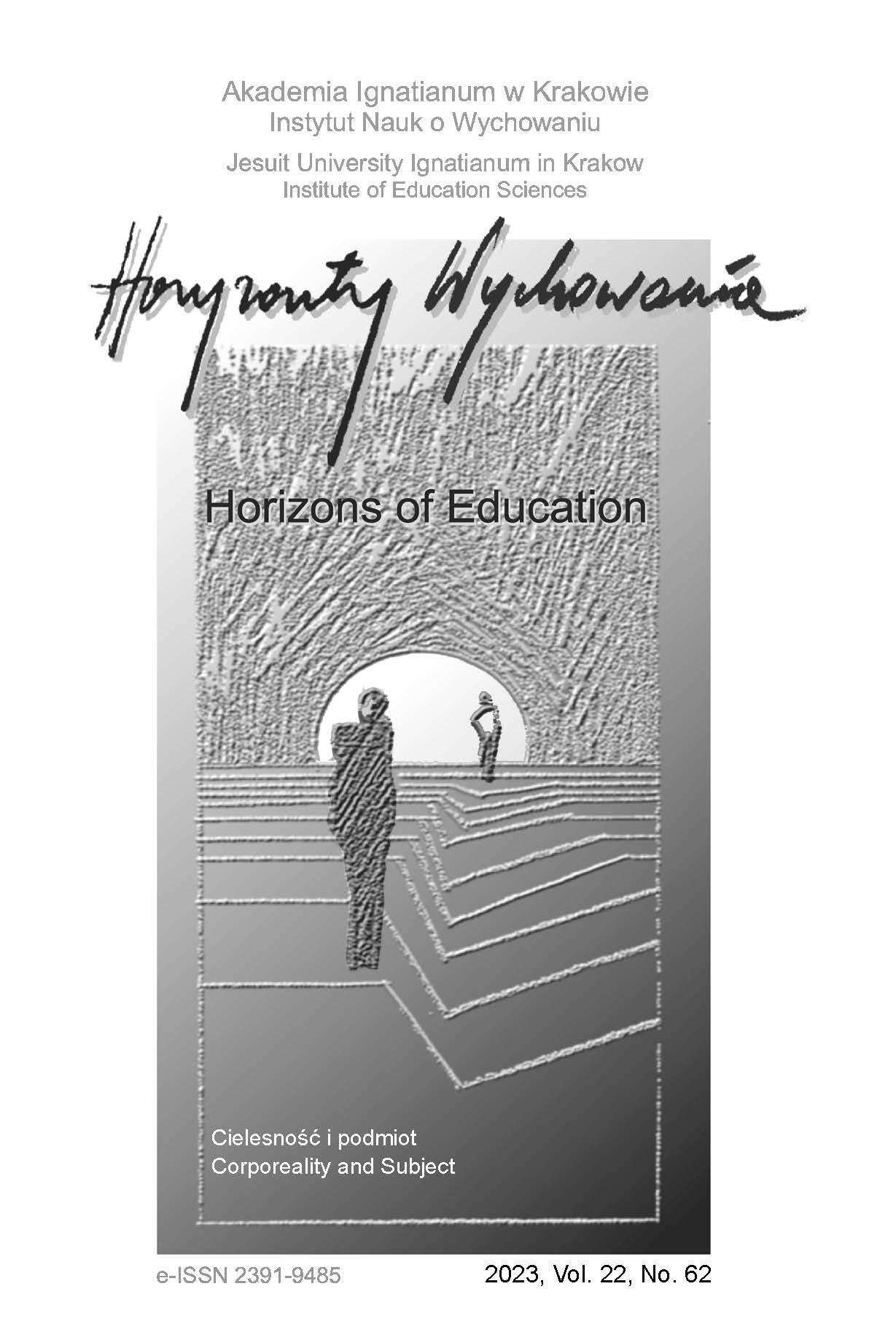Corporeality and Identity of the Subject
Abstract
RESEARCH OBJECTIVE: The objective of this paper is to present a synthetic description of corporeality (“including” the body) and its relation to the identity of the subject conceived in “yet an- other” way in contemporary humanistic and social discourse.
THE RESEARCH PROBLEM AND METHODS: The main research problem addressed in this article concerns the relationship between corporeality and the identity of the subject. In order to establish it, it is necessary to ask the question what meanings are given to the body and corporeality in contemporary humanistic and social discourse. The author applies the principle of research framing based on a prior qualitative analysis of the selected literature on the subject.
THE PROCESS OF ARGUMENTATION: The first part of the paper presents the category, term and concept of the body in contemporary humanistic and social discourse. This serves as a pretext, but above all as a basis for reflecting on the impossibility of treating the body and corporeality separately. These considerations lead to disclosing the identification of corporeality (and, hence, the body, although the paper does not address the topics of having a body, being in the body, being outside the body) as the source and matrix of the subject’s identity.
RESEARCH RESULTS: A conceptualisation of corporeality as the source and matrix of the subject’s identity is presented on the basis of a qualitative analysis of selected literature on the subject.
CONCLUSIONS, INNOVATIONS AND RECOMMENDATIONS: Assuming that when thinking about the subject and its identity, corporeality and its conceptualisations constitute their framework, what is important is what they are and how they can be different, also different from the conceptualisation presented in the paper, and how the subject and its identity are presented in their context
References
Adolphi, R. (2015). Ciało wkracza na scenę. O wypartym doświadczeniu i metaforyce cielesności. Filozofia Publiczna i Edukacja Demokratyczna, 4(2), 122-142.
Barbaras, R. (2008). Introduction à la phénoménologie de la vie. Librairie Philosophique J. Vrin.
Barbaras, R. (2017). Trzy znaczenia pojęcia „żywe ciało” (J. Migasiński, tłum.). W: J. Migasiński i M. Pokropski (red.), Główne problemy współczesnej fenomenologii (s. 80-96). Wydawnictwa Uniwersytetu Warszawskiego.
Bauby, J.-D. (2013). Skafander i motyl (K. Rutkowski, tłum.). Słowo/Obraz Terytoria.
Boehm, G. (2014). O obrazach i widzeniu. Antologia tekstów (M. Łukasiewicz iA. Pieczyńska-Sulik, tłum.). Universitas.
Depraz, N. (2006). Comprendre la phénomenologie. Une pratique concrète. Armand Colin.
Depraz, N. (2017). Transcendentalna empiryczność fenomenologii (A. Dwulit, tłum). W: J. Migasiński i M. Pokropski (red.), Główne problemy współczesnej fenomenologii (s. 97-130). Wydawnictwa Uniwersytetu Warszawskiego.
Gallagher, S. i Zahavi, D. (2015). Fenomenologiczny umysł (M. Pokropski, tłum.). Wydawnictwo Naukowe PWN.
Heidegger, M. (2020). Źródło dzieła sztuki (B. Jasiński, tłum.). Wydawnictwo Ethos.
Jullien, F. (2009). Les transformations silencieuses. Éditions Grasset et Fasquelle.
Jullien, F. (2017). Une seconde vie. Commencer véritablement d’exister. Éditions Grasset et Fasquelle.
Lyotard, J.-F. (1998). Postmodernizm dla dzieci. Korespondencja 1982-1985 (J. Migasiński, tłum.). Fundacja Aletheia.
Łebkowska, A. (2019). Somatopoetyka – afekty – wyobrażenia. Literatura XX i XXI wieku. Wydawnictwo Uniwersytetu Jagiellońskiego.
Łeńska-Bąk, K. i Sztandara, M. (red.). (2008). Doświadczane, opisywane, symboliczne. Ciało w dyskursach kulturowych. Wydawnictwo Uniwersytetu Opolskiego.
Merleau-Ponty, M. (1996). Widzialne i niewidzialne (M. Kowalska, J. Migasiński, R. Lis i I. Lorenc, tłum.). Fundacja Aletheia.
Merleau-Ponty, M. (2001). Fenomenologia percepcji (M. Kowalska i J. Migasiński, tłum.). Fundacja Aletheia.
Migasiński, J. (2017). Wprowadzenie. W: J. Migasiński i M. Pokropski (red.), Główne problemy współczesnej fenomenologii (s. 25-43). Wydawnictwa Uniwersytetu Warszawskiego.
Nancy, J.-L. (1992). Corpus. Métailité.
Ricoeur, P. (2005). O sobie samym jako innym (B. Chełstowski, tłum.). Wydawnictwo Naukowe PWN.
Schmitz, H. (2001). Ciałosfera, przestrzeń i uczucia (B. Andrzejewski, tłum.). Oficyna Wydawnicza Garmond.
Schmitz, H. (2015). Nowa fenomenologia. Krótkie wprowadzenie (A. Przyłębski, tłum.). Fundacja Aletheia.
Shusterman, R. (2016). Świadomość ciała. Dociekania z zakresu somaestetyki (W. Małecki i S. Stankiewicz, tłum.). Universitas.
Szkudlarek, T. (2012). Tożsamość. W: M. Cackowska, L. Kopciewicz, M. Patalon, P. Stańczyk, K. Starego i T. Szkudlarek, Dyskursywna konstrukcja podmiotu. Przyczynek do rekonstrukcji pedagogiki kultury (s. 303-356). Wydawnictwo Uniwersytetu Gdańskiego.
Szpakowska, M. (red.). (2008). Antropologia ciała. Zagadnienia i wybór tekstów. Wydawnictwa Uniwersytetu Warszawskiego.
Walczak, A. (2021a). Ciało i cielesność – ku doświadcze(a)niu egzystencjalnemu. Humaniora, 35(3), 13-29.
Walczak, A. (2021b). (Re)conceptualizing difference in the context of the acting subject’s identity. Nauki o Wychowaniu. Studia Interdyscyplinarne, 13(2), 88-108
Copyright (c) 2023 HORIZONS OF EDUCATION

This work is licensed under a Creative Commons Attribution-NoDerivatives 4.0 International License.
Authors who publish in this journal agree to the following terms:
- Authors retain the copyright to their work while granting the journal the right of first publication. The work will be simultaneously licensed under a CC BY-ND license, which permits others to share the work with proper credit given to the author and the original publication in this journal.
- Authors may enter into additional, non-exclusive agreements for the distribution of the published version of the work (e.g., posting it in an institutional repository or publishing it in another journal), provided that the original publication in this journal is acknowledged.
We allow and encourage authors to share their work online (e.g., in institutional repositories or on personal websites) both before and during the submission process, as this can foster beneficial exchanges and lead to earlier and increased citations of the published work. (See The Effect of Open Access). We recommend using any of the following academic networking platforms:





